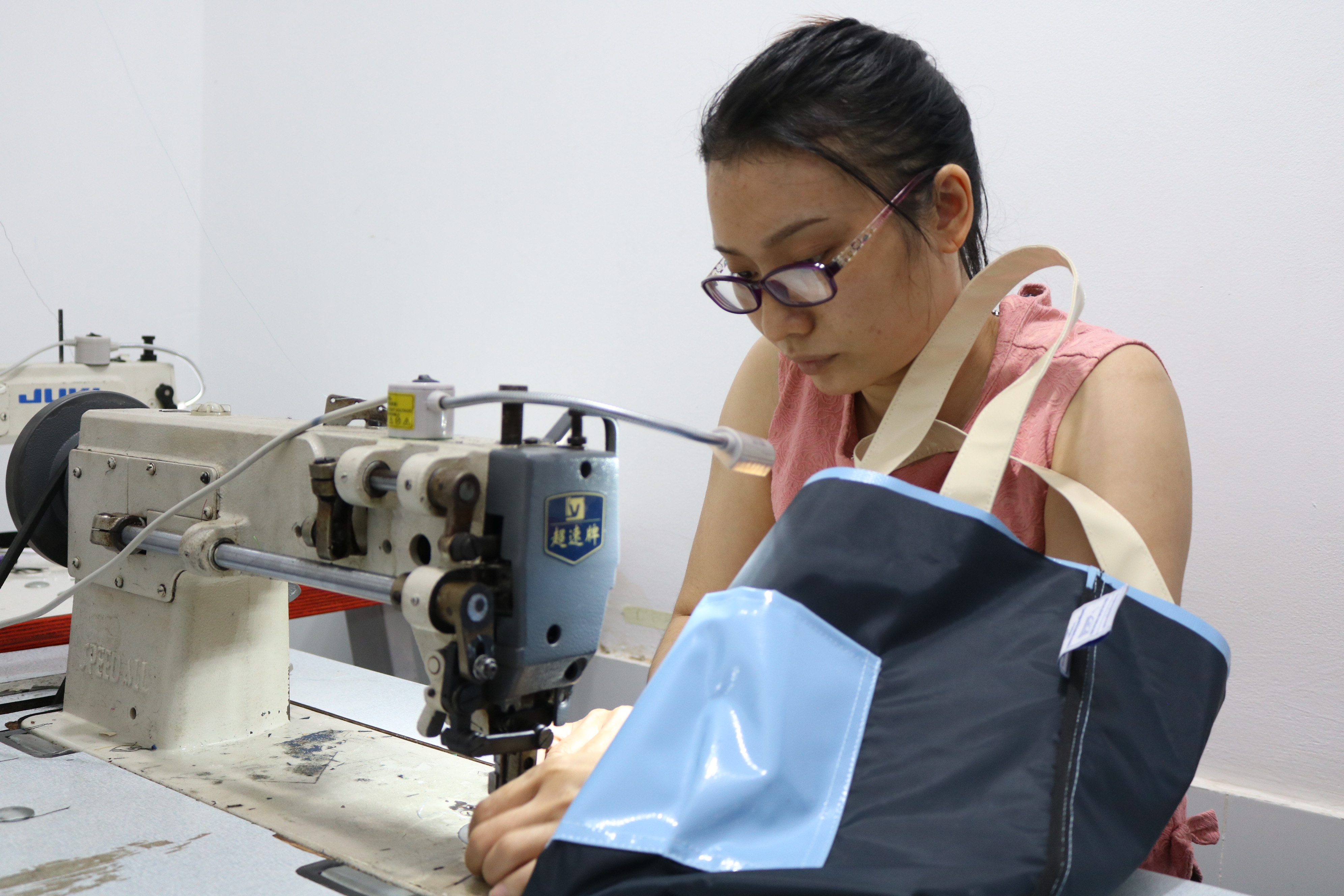A sustainability initiative in Ho Chi Minh City has been working to give discarded tarps a second life by recycling them into bags and accessories.
The idea to recycle old tarps struck UX designers Kieu Anh and Thao Trang on a rainy afternoon in late 2019 while the two were enjoying a drink in a small coffee shop.
Little did they know their optimistic plan would blossom into new careers aimed at protecting the environment.
“We saw an old awning in a nearby trash bin,” Kieu Anh recalled.
“It was slightly worn, but still durable. It couldn’t shelter a house anymore, but we figured it could probably be recycled into something useful, like a bag.”
A few months later, the duo founded Dong Dong Sai Gon, an accessory brand that recycles plastic tarps into bags, backpacks, and other goods.
Initially, Kieu Trang and Thao Anh attempted to fashion bags from several types of recycled plastic sheeting, but found that only awnings and truck tarps were durable enough for backpacks.
That was their first learning curve. It took three months and hundreds of attempts until they produced a successful product.
 |
| Tu Quan (left), Thao Trang (center), and Kieu Anh, members of Dong Dong Sai Gon, are seen in a supplied photo. |
When trash becomes treasure
Tu Quan, a member of Dong Dong Sai Gon, was doing her job when Tuoi Tre News’ correspondents visited the brand’s workshop in District 2 in August this year.
“It feels like we’ve just won the lottery finding this,” Quan said with a big smile while cleaning a piece of tarp with images of banh mi, or Vietnamese sandwich, on it.
The tarp had previously been an awning at a banh mi store in the city. Now it was being cleaned and readied to be transformed into a bag.
|
|
| Thao Trang (left) and Tu Quan, two members of Dong Dong Sai Gon, clean old tarps before turning them into bags at the brand’s workshop in Ho Chi Minh City, August 2020. Photo: Hoang An / Tuoi Tre |
“The tarps we collect usually have information for a store, or the name of a restaurant, and sometimes food pictures on them,” Dong Dong Sai Gon co-founder Kieu Anh explained.
“If you cherish those details and use them properly in making bags and backpacks, they make for very unique products.”
|
|
| A backpack made from the old awning tarp of a snail restaurant in Ho Chi Minh City by Dong Dong Sai Gon is seen in a promo photo published on the brand’s Facebook page. |
Each member of Dong Dong Sai Gon’s six-person team helps classify, clean, cut, sew, and package the group’s products, which include tote bags, wallets, pen cases, and luggage tags.
‘Nothing goes to waste’ seems to be the brand’s motto as they make use of every aspect of the rescued tarps.
While actually producing the products might seem difficult, it is sourcing the old tarps that is the hardest part.
It takes a surprising amount of effort to convince people to sell their ‘trash,’ the team explained.
According to Tu Quan, the old tarps used by Dong Dong Sai Gon come from many sources, including leftovers from shops selling new tarps, old tarps discharged from suppliers when they replace awnings for their customers, and from restaurants changing their awnings.
“The industry always has leftover materials and people just throw them away,” Thao Trang said.
“There are tarps the size of sofas that get discarded because people can’t figure what to use them for.
“We collect them and turn them into valuable products if they’re in decent shape.”
The team also works with local scrap dealers but purchasing from such sources is not always an easy process.
Each deal with a local scrap dealer begins with a Google search.
After finding potential useable tarps, a member of Dong Dong Sai Gon calls the source and attempts to make a deal.
Sometimes their first offer is rejected, but usually the team is successful if they are persistent enough.
“It may sound like there are many sources for used tarps but really people are unfamiliar with the idea of selling their trash,” Kieu Anh explained.
“They prefer to just throw it away. It takes a lot of convincing to get them to change their ways.”
On one occasion, the group even traveled across the city through District 12, Binh Chanh, Hoc Mon, and Tan Binh Districts to collect tarps.
The trip, though long, resulted in the team proudly securing a 90-square-meter tarp.
After finding a tarp, the group examines it to decide what products it can be used for.
 |
|
Members of Dong Dong Sai Gon are seen in a photo published on their Facebook page on September 15, 2020 capturing a trip to collect old tarps in the southern province of Dong Nai. |
Truck covers and awning tarps are used to make backpacks because they are the most durable and weather-resistant, while other less durable tarps are recycled into bags and other accessories.
To clean their materials before processing them, Dong Dong members use environmentally friendly substances such as antiseptic liquid, vinegar, and baking soda.
The next steps are cutting, ironing, and sewing.
Tarps that go around
‘Dong Dong Sai Gon’ is a local saying that roughly means ‘to go around Saigon,’ a metaphor for the life cycle of used tarps which includes transforming from old awnings or truck covers to the unique bags, the brand explained its name on its website.
Dong Dong Sai Gon customers often find little messages on their purchases saying things like “Hi, I used to sit in a corner at Cho Lon” or “I used to shelter a coffee shop in Binh Thanh.”
“We hope customers see the beauty of discarded items because each bag made from recycled tarp carries its own story about Saigon,” Kieu Anh explained.
Indeed, scratches from the tarps’ previous life are treated by the team as unique patterns for their products.
“We don’t try to wash away the story of the tarp itself,” they insisted.
|
|
|
A tote bag made from old tarp by Dong Dong Sai Gon is seen in a supplied promo photo. |
A tote bag made from old tarp by Dong Dong Sai Gon is seen in a supplied promo photo.
The Dong Dong Sai Gon team members expressed their hope to become a top choice for customers seeking out local brands with fine products made from simple materials that embody the lifestyle and culture of the place they live in.
“Old things often have a lot to tell,” Kieu Anh said.
“Awnings are often too ordinary for people to pay attention to, but when each of the details is cut out, it can convey the beauty and a feeling of bustling Saigon.”
Kieu Anh also insisted that the team wants customers to buy its products thanks to their quality so that the tarps’ lifespan can be extended, because “if people buy them only to show that they are contributing to the environment and don’t use them, we’re not really ‘saving’ the tarps.”
Dong Dong Sai Gon’s products have not only caught the eyes of local customers but also drawn attention from foreigners who said they saw the brand’s bags as ‘very Vietnamese’ souvenirs which they hope to bring to their family and friends back home.
|
|
| Thao Trang, co-founder of Dong Dong Sai Gon, arranges bags at a display area at the brand’s workshop in Ho Chi Minh City, August 2020. Photo: Hoang An / Tuoi Tre |
|
|
| Luu Doan Hong Cam works on a tote bag made from discarded tarps at the Dong Dong Sai Gon workshop in Ho Chi Minh City, August 2020. Photo: Hoang An / Tuoi Tre |
|
|
| Tu Quan, a member of Dong Dong Sai Gon, packages a tote bag for delivery to a customer at the brand’s workshop in Ho Chi Minh City, August 2020. Photo: Hoang An / Tuoi Tre |
|
|
| Kieu Anh, co-founder of Dong Dong Sai Gon, irons tarps before moving them to the next step for sewing at the brand’s workshop in Ho Chi Minh City, August 2020. Photo: Hoang An / Tuoi Tre |
|
|
| Tarp samples at Dong Dong Sai Gon’s workshop in Ho Chi Minh City, August 2020. Photo: Hoang An / Tuoi Tre |
|
|
| Dong Dong Sai Gon’s logo on a piece of tarp being ironed at the brand’s workshop in Ho Chi Minh City, August 2020. Photo: Hoang An / Tuoi Tre |
Like us on Facebook or follow us on Twitter to get the latest news about Vietnam!































